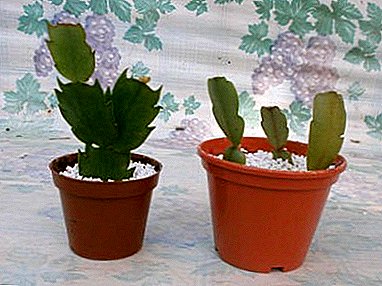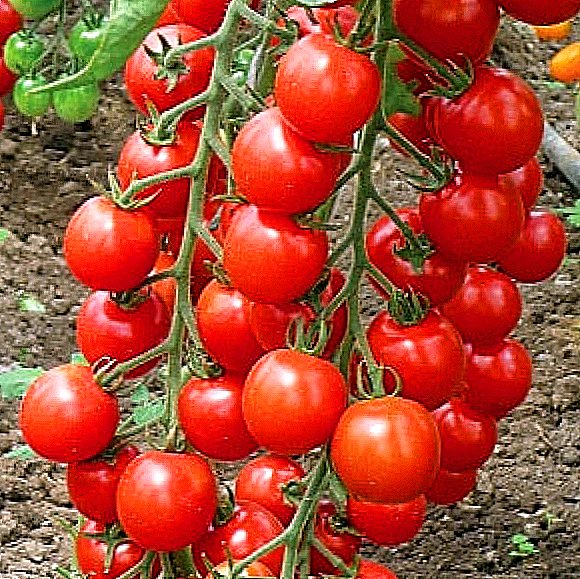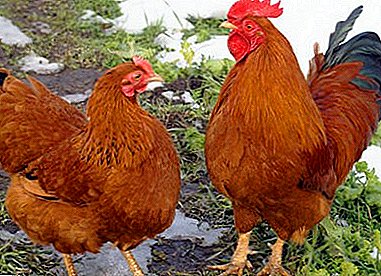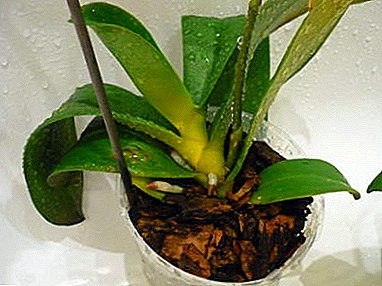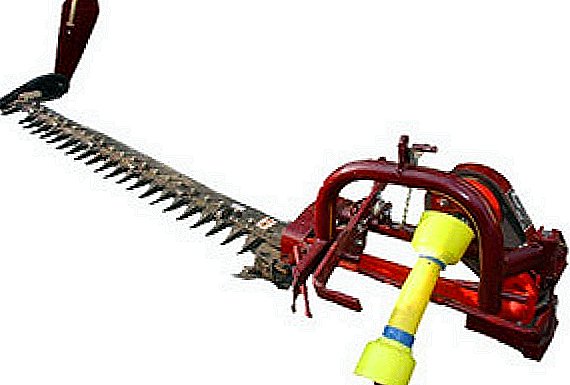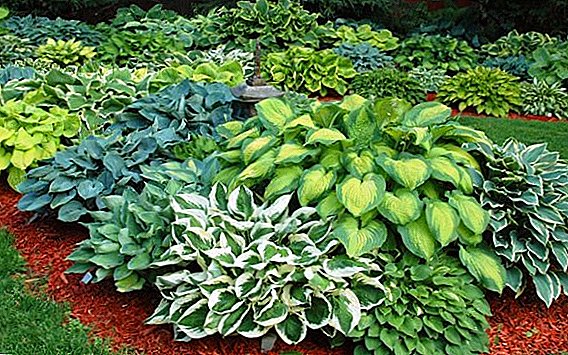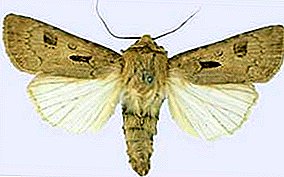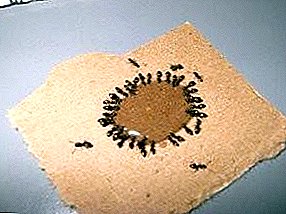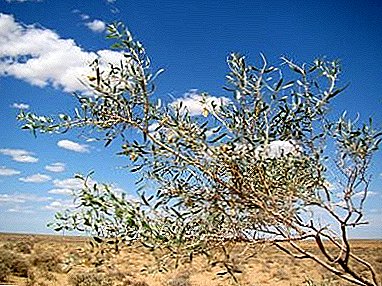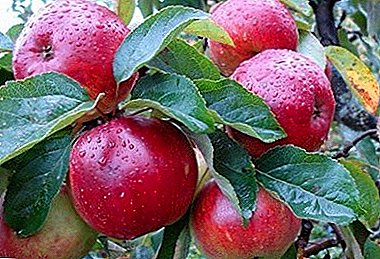
The variety of apple varieties is truly huge. They differ in terms of ripening of fruits, their size, taste, shape of the crown, the cyclical nature of fruiting.
And therefore, before you plant an apple tree on your land, you need to clearly define what you would like to get from the tree.
If the most important factor is keeping quality of fruitsthen a good option could be variety Antey.
What kind is it?
 Antey - winter variety. Apples can be stored in a cool, well-ventilated area for 5-6 months.
Antey - winter variety. Apples can be stored in a cool, well-ventilated area for 5-6 months.
However, they do not dry out due to the dense skin and pulp, and for the same reason do not suffer during transport.
No less hardy and the tree itself, giving so durable and strong fruit.
In 1996, Antey was introduced to the State Register of varieties and tree-handicraft species of Belarus for his endurance and abundant fruiting.
Antey refers to winter-hardy varieties and is able to grow safely and bear fruit in regions of Russia, where in winter the temperature drops below thirty degrees.
Winter varieties also include: Idared, Golden Delicious, Granny Smith, Aport and Antonovka ordinary.
Pollination
Most of the apple trees self-infertile, for fruiting, they require trees with which cross-pollination is possible.
 Antey is no exceptiontherefore it is recommended to plant it next to other varieties with an average flowering period.
Antey is no exceptiontherefore it is recommended to plant it next to other varieties with an average flowering period.
It can be almost any autumn or summer varieties - of which the best are: Welsey, Anise, Autumn Striped, Pepin saffron. Winter varieties pereopilyatsya bad among themselves.
As a pollinator, you can use the summer varieties Golden Summer, Daughter Papirovka, Yandykovsky, Orlov and Summer.
Description variety Antey
Consider separately the appearance of the apple and the fruit itself.
Tree height is average reaches 2.5 meters.
Crohn sparse, round pyramid, clearly divided into tiers, which facilitates formative and sanitary pruning, as well as the collection of fruits.
The leaves are large, dark green, have long petioles, along the edge are carved with rounded teeth, and the stipules are semi-lunar or lancet-like.
The base of the sheet is rounded, the tip is pointed.
Fruiting is mixed, but the rings are dominant, the tree can begin to blossom and fructify from two or three years more.
Flowering time average - buds bloom in mid-May.
 Variety apples Antey different large sizetheir average weight is 200 to 250 grams.
Variety apples Antey different large sizetheir average weight is 200 to 250 grams.
These apples have a blunt-conical, slightly faceted shape with a rather wide folded saucer and a deep, usually erupted funnel.
Sepals are closed, occasionally can be half-open.
The stem is often slanting.
The fruit is covered in bright red or purple, evenly blurred along the basic green tone.
Wax abundant patina gives the peel a bluish tint.
The flesh of apples of this variety is dense, juicy, pale greenish, the bones are large, the seed chambers are open, medium-sized, heart-shaped.
A photo


Breeding history
Antey was bred by an employee of the Belarusian Research Institute for Potato, Vegetable and Fruit Growing, G.K. Kovalenko, by crossing apple tree varieties Newtosh and Grandma's, and the subsequent crossing of the received hybrid with Belarusian crimson.
This was not the first successful attempt by the breeder to create a fruitful and tasty winter variety of apples - the Belarusian raspberry was also his brainchild. Antey inherited many qualities from this variety.
Natural growth region
 Despite the fact that the Antey variety was created in fairly southern latitudes, where freezing winters are rare, This apple tree is not afraid of cold.
Despite the fact that the Antey variety was created in fairly southern latitudes, where freezing winters are rare, This apple tree is not afraid of cold.
The tree is quite unpretentious and does not require any additional measures for adaptation in regions with a harsh climate.
In addition, the flowering period allows the buds and ovaries of the plant to avoid strong spring frosts.
When planting young seedlings it is useful to treat the root system with phytohormones to stimulate the formation of new roots and faster adaptation to new conditions.
Yield
Unlike most other varieties of apples, Antey does not have a clearly pronounced recurrence in fruiting.
He lays flower buds not in a year, but Every yeartherefore even in those seasons when other apple trees practically do not produce crops, the trees of this variety are covered with ripening fruits.
The number of apples on one adult plant is about 50 kilograms, by planting in a five-by-three pattern, harvest up to 40 tons per square hectare the garden. Due to its regular and abundant fruiting, this variety is commercially valuable.
Fruits reach maturity in the second half of September or early October.
Their consumer maturity comes around two months after picking apples, the tone of the peel and the pulp becomes slightly warmer, slightly yellowish.
From winter to mid-spring, Antey preserves all tastes.
Pay attention to other fruitful varieties of apple trees: Dessert Petrova, Papirovka, Orlovskoye Polesye, Marat Busurin and Orlovskoye Polesye.
Planting and care
 It is an undemanding plant. does not need labor-intensive care.
It is an undemanding plant. does not need labor-intensive care.
All his needs are limited by the elementary procedures that are necessary for all other varieties of apple trees:
- watering in dry weather
- top dressing
- formative trimming,
- sanitary pruning,
- treatment against pests and diseases.
Start planting young trees better in the autumn, not in the spring - after leaf fall, the period in which the plant safely takes root is much longer than before bud break.
Over the summer, the plants managed to accumulate nutrients before hibernation, their growth period ended, and they transfer to a new place quite easily, the main thing - to have time to land them in the ground before frosts, to have time to appear fresh roots.
For planting apple trees need to choose a well-lit area with a light and sufficiently fertile neutral soil.
Highly buried groundwater and acidified land is not the best option, it is worth take care that the territory of the future garden is dry enough.
The roots, however, are dangerous to dry., before disembarking it is necessary to keep them slightly damp, wrapped with a waterproof material, and immediately when preparing to place the seedlings in a permanent place - put them in water for a few hours.
 After pruning dead and broken roots, a mound of fertile garden soil is poured into a pit prepared for an apple tree, in which they are evenly distributed.
After pruning dead and broken roots, a mound of fertile garden soil is poured into a pit prepared for an apple tree, in which they are evenly distributed.
Pit need to dig, given that the root of the neck should be 2-3 centimeters above the ground.
Deepening the cervix at best can lead to delayed development and fruiting, at worst the plant will die.
Having dug in, if necessary, a support peg, you need to fill the roots with earth, carefully compacting it as it is poured into a hole.
You can not trample it too much. A small mound should remain above the soil level, which will settle after abundant watering.
Having tied up and watering a sapling (it is useful to add stimulants of rooting to the water), it remains only to fill the soil if it has settled heavily, and you can leave it to settle down quietly.
Pruned apple trees in spring from March to May.
Thanks to the rare crown divided into tiers, the Anteas are easily formed in an optimal way, and work on the correct arrangement of the branches requires minimal.
But removal of tops, dead branches should be made regularly. Dead branches are a hotbed of fungus and woodworm, they cannot be left on the tree.
 In hot dry weather, trees need watering. The optimum amount of water sufficient to impregnate the soil layer with the roots - 50-80 liters.
In hot dry weather, trees need watering. The optimum amount of water sufficient to impregnate the soil layer with the roots - 50-80 liters.
For good growth and fruiting, apple trees are fed with fertilizers, which contain a sufficient amount of flower buds important for planting. phosphorus and nitrogen.
It can be as complex mineral fertilizers, and organic - one is perfect bird droppings. Fertilizer application is usually carried out:
- after flowering,
- at the beginning of the ripening of fruits,
- in August-September (to support the root system).
The frequency of fertilization depends on the fertility and density of the soil.
If the land is light, permeable and poor, then it is desirable to fertilize trees every year, in a more dense and oily substrate they will feel good, receiving top dressing every three years.
With enough nutrients, moisture and light, the apple trees will quickly begin to fruit abundantly regularly.
Diseases and pests
Antey possesses moderate pest resistance. The following insects threaten him:
- aphid;
- leafworm;
- silkworm;
- apple sawfly;
- flower eater;
- mining mole;
- weevil;
- fruit sap;
- hawthorn;
- Codling moth.
 In order to avoid tree infestation by parasites, loss of crop yields and plant health, it is necessary to use complex-effect insecticides every evening, such as Nerthus and DuPont, installation of traps with a pest-attracting fluid and trapping belts sticking parasites along the trunk to the branches.
In order to avoid tree infestation by parasites, loss of crop yields and plant health, it is necessary to use complex-effect insecticides every evening, such as Nerthus and DuPont, installation of traps with a pest-attracting fluid and trapping belts sticking parasites along the trunk to the branches.
From folk remedies apply lube oil solution and strong tobacco solution.
Also Antey prone to scab.
This fungal disease spoils the fruit and damages the leaves. It most often occurs there, where is summer raw and cold, but even residents of the southern regions are not insured against the appearance of scab in their garden.
Only timely treatment with fungicides and keeping plants healthyA strong condition can relieve the gardener of this problem.
Antey is a variety that, with a minimum of care, gives a bountiful harvest suitable for raw consumption and any processing option for delicious apples.
Their keeping quality, as well as high winter hardiness and regular fruiting without pronounced periodicity make it one of the varieties deserving close attention.
Among the unpretentious varieties should pay attention to the freshness, Oryol Sinap, Scarlet Early, Bryansk Golden and Moscow Late.
Watch a video with tips from Oktyabrina Ganichkina on how to save the apple crop from butterfly moths.


